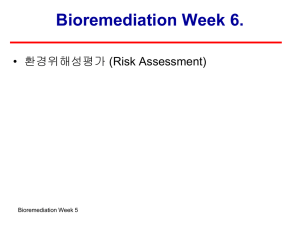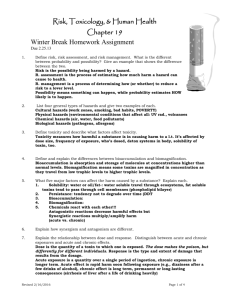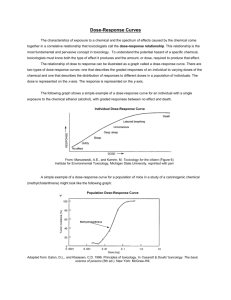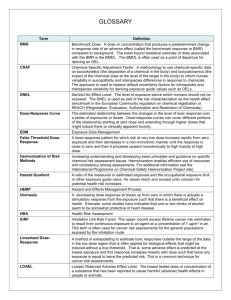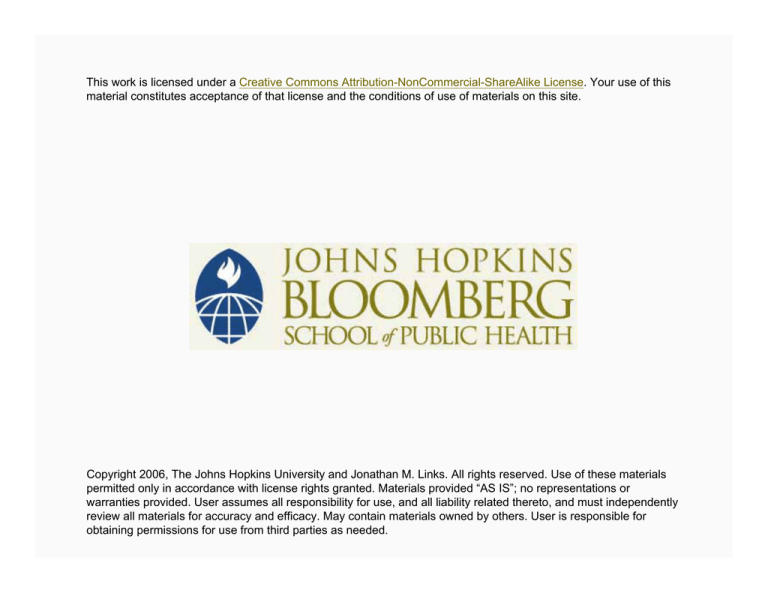
This work is licensed under a Creative Commons Attribution-NonCommercial-ShareAlike License. Your use of this
material constitutes acceptance of that license and the conditions of use of materials on this site.
Copyright 2006, The Johns Hopkins University and Jonathan M. Links. All rights reserved. Use of these materials
permitted only in accordance with license rights granted. Materials provided “AS IS”; no representations or
warranties provided. User assumes all responsibility for use, and all liability related thereto, and must independently
review all materials for accuracy and efficacy. May contain materials owned by others. User is responsible for
obtaining permissions for use from third parties as needed.
Risk Assessment and Management
Jonathan M. Links, PhD
Johns Hopkins University
Section A
Overview
Objectives of Risk Analysis
Balance risks and benefits
Set target levels of risk
Set priorities for program activities
Estimate residual risks and extent of risk reduction after steps
are taken to reduce risk
4
What Is Risk?
The potential for realization of unwanted, negative
consequences of an event
The probability of an adverse outcome
The downside of a gamble (the total gamble must be
considered)
Safe means “without risk”
There is usually no such thing as zero risk
5
Risk Analysis Activities: Risk Assessment
Risk assessment
− The systematic characterization of potential adverse
health effects resulting from human exposure to
hazardous agents
6
Risk Analysis Activities: Risk Management
Risk management
− The process of weighing policy alternatives and selecting
the most appropriate regulatory action based on the
results of risk assessment and social, economic, and
political concerns
7
Risk Analysis Activities: Risk Communication
Risk communication
− The process of making risk assessment and risk
management information comprehensible to lawyers,
politicians, judges, business and labor, environmentalists,
and community groups (public)
8
Four Steps of Risk Assessment
Hazard
identification
Exposure
assessment
Dose-response
assessment
Risk
characterization
Risk
communication
Risk
management
9
Risk Assessment Process
Hazard
identification data
Risk
characterization
Dose-response
evaluation data
Human exposure
evaluation data
Level of potential
risk to humans
10
1. Hazard Identification
Agent
??
Effect
Example: Does a chemical of
concern cause an adverse effect?
11
1. Hazard Identification
Agent
LD50 (mg/kg)
Sucrose
30,000
Ethanol
10,000
Aspirin
1,000
Phenobarbital
150
Caffeine
192
DDT
113
Strychnine
16
Sodium cyanide
6
Nicotine
1
Tetrodotoxin
Dioxin
Botulism toxin
0.1
0.001
0.00001
12
1. Hazard Identification
Review and analyze toxicity data
− What is the LD50 for various agents?
Weigh the evidence that an agent causes various toxic effects
− Description of the specific form of toxicity (neurotoxicity,
carcinogenicity, etc.)
Evaluate whether toxic effects in one setting will occur in
other settings
− Quantification of the concentrations at which they are
present in the environment
13
Sources of Toxicity Data
Human studies
− Case reports
− Cluster analyses
− Epidemiologic studies
Animal studies
− Specialized tox. studies
− Generalized tox. studies
In vitro studies
14
Range of Observed Human Studies
Case reports
− Clinicians observations
− Surveillance systems
− Clusters
Descriptive studies
− Vital statistics
− Cancer registry data
15
Range of Observed Human Studies
Analytic studies
− Cohort studies
− Case-control studies
16
Why Animal Studies?
Good correlation with human disease
− Human carcinogens cause cancer in animals
Acute toxic doses are similar in humans and a variety of
animals
Anatomical, physiological, and biochemical patterns are
similar among mammals
Accepted by the scientific community
17
Design Issues for Animal Testing
Route of administration
Test species
Controls
Number of test subjects
Dose selection
Duration of study
Observations to be made
18
National Toxicology Program (NTP) Testing Guidelines
NTP guidelines for carcinogenicity testing
− Two species of animal
X Rats (Fisher 344)
X Mice (B6C3F1)
− Number and gender of animals per group
X 50 males
X 50 females
X 2%+ incidence (one cancer in group of 50)
− Doses (one group per dose)
X Maximum tolerated dose (MTD)
X One-half MTD
X One-fourth MTD
X 0 (vehicle controls)
19
NTP Guidelines for Carcinogenicity Testing
Regimen for dosing
− Begin at 6 weeks and end at 24 months of age
Endpoints
− 38 histopathologic samples/animal examined
20
Potential Endpoints
Respiratory
Blood and lymph
Liver
Kidney
Nervous system
Skin
Reproductive toxicity
Teratogenicity
21
Criteria for Causality
Temporality
− Exposure precedes effect
Biological plausibility
Consistency
Dose-response
Strength of association
Specificity
22
Section B
Dose-Response Assessment
2. Dose-Response Assessment
Dose
??
Response
How is the identified adverse
effect influenced by the level of
exposure or dose?
24
Dose-Response Curve
25
Dose-Response Relationship: Carcinogen
26
Dose-Response Relationship: Non-Carcinogen
Dose (mg/kg/day)
Source: Adapted from Cockersham, L. G. and Shane, B. S.
27
Uncertainty Factors
(Toxicity Study)
LOAEL or NOAEL
Uncertainty Factor
= “Safe Level”
LOAEL = Lowest observable adverse effects level; the lowest
dose tested that produced an effect
NOAEL = No observable adverse effects level; the highest
dose tested that did not produce an effect
28
Uncertainty (Safety) Factors
Uncertainty (safety) factors for risk assessment of non-cancer
effects
− 10 for human variability
− 10 for extrapolation from animals to humans
− 10 for use of less than chronic data
− 10 for using LOAEL instead of NOAEL
29
Hazard ID and Dose-Response Assumptions, Defaults
Major EPA assumptions and defaults for hazard identification
and dose-response data
− Select human data over animal data
− Use animal data when human data is inadequate
− Select most sensitive animal species/strain
− Apply standard uncertainty factors to scale between
species
− Apply linearized multistage model for low-dose
extrapolation
30
Linear Extrapolation in Quantitative Risk Assessment
Illustration by JHSPH CTLT
31
3. Exposure Assessment
Agent
??
People
What exposures are experienced
or anticipated under different
conditions?
32
Human Exposure Evaluation
Where is the agent found?
What are the routes of exposure?
How many people are exposed?
Who is exposed?
What is the intensity, frequency, and duration of exposure?
33
Exposure Assessment
Characterization of the exposure setting
Identification of the exposure pathway
Quantification of exposure
Exposure = intensity x frequency x duration
Exposure = how much x how often x how long
34
Hierarchy of Exposure Data or Surrogates
Types of Data
1. Quantitative personal dosimeter
measurements
Approx. to
Actual Exp.
Best
2. Quantitative ambient measurements in
vicinity of residence or activity
3. Quantitative surrogates of exposure—
e.g., estimates of drinking water or food
consumption
4. Residence or employment in proximity of
source of exposure
5. Residence or employment in general geographic area (e.g., county) of site or source
of exposure
Poorest
35
4. Risk Characterization
What is the estimated likelihood of the adverse effect
occurring in a given population?
Hazard
identification
Exposure
assessment
Risk
characterization
Doseresponse
36
4. Risk Characterization
Integrate and summarize the hazard identification, exposure
assessment, and dose-response assessment
Develop public health risk estimates
Develop a framework to define the significance of the risk
Present assumptions, uncertainties, and scientific judgements
37
Risk Assessment As “Science”
Imprecise, as it lacks full scientific evidence to support many
of the concepts
Many assumptions are made, since complete data are often
not available
Many models are based on hypothetical mechanism, which
may or may not be scientifically validated
38
Risk Assessment As “Science”
Great deal of uncertainty is inherent in the exercise
Due to uncertainty and the desire to protect human
populations, risk assessments are generally conservative and
overestimate risk
39
Risk Assessment Uncertainties
Hazard identification
– Use of animal data
– Negative epidemiologic
studies
Human exposure evaluation
– Modeling vs. ambient
– Monitoring vs. biological
monitoring
– Inappropriate exposure
paradigm
Dose-response evaluation
– Extrapolation from high to
low dose
– Extrapolation from animals
to humans
– Misclassification of response
Risk characterization
– Qualitative or quantitative
40
Ranges of Some Estimated Carcinogenic Risks
Range of estimates of human carcinogenic risk of selected
chemicals
Agent
Low estimate
High estimate
High/low
.001/106
5,200/106
5.2 x 106
Vinyl chloride
1/108
107/108
107
Trichloroethylene
1/106
7 x 104/106
7 x 104
Saccharin
41
Section C
Legal Aspects of Risk
Legal Aspects of Risk
“De minimis” concept (de minimis non curat lex—the law does
not concern itself with trifles)
− In some cases, the computed risk is so small that it does
not justify regulation
− Designed to protect down to a level of one in a million
X Essentially zero, virtually a “safe dose”
43
Legal Aspects of Risk
Risk assessment
− To determine what level of an agent will produce an
effect in one individual out of one million exposed
individuals
44
One in a Million Risks
Risks estimated to increase chance of death in any
year by 0.000001 (one in a million)
Activity
Type of Risk
Smoking 1.4 cigarettes
Cancer, heart disease
Spending 1 hour in a coal mine
Black lung disease
Living 2 days in New York City
Air pollution
Traveling 300 miles by car
Accident
Traveling 10 miles by bicycle
Accident
One chest X-ray
Cancer (radiation)
Eating 1 tbsp. of peanut butter
Cancer (aflatoxin)
Drinking 30 12-oz. cans of soda
Cancer (saccharine)
Living 20 years within 20 miles
of a nuclear power plant
Cancer (radiation)
Source: Data from Wilson, R. (1979). Technol Rev, 81, 41–46.
45
Risk Communication
Risk communication is an interactive process of exchange of
information and opinion among individuals, groups and
institutions. It involves multiple messages about the nature of
risk and other messages, not strictly about risk, that express
concerns, opinions, or reactions to risk messages or to legal
and institutional arrangements for risk management.
Source: NRC. (1989). Risk Communication.
46
The Receding Zero
It is commonly believed that any amount of unwanted
chemicals in our air, food, or water is harmful; that is not so
The mere presence of a chemical is insufficient to warrant
alarm
People are naturally distressed when they hear that
trichloroethylene is in their drinking water—water believed
to be pure
47
The Receding Zero
The fact is that the very definition of purity has been turned
upside down by our ever-increasing ability to measure
smaller and smaller amounts of substances
As that ability has increased, we have come to realize that
“purity” is elusive, permanently limited by the intensity of our
analytic method
48
Minimum Detectable Level
Minimum amount or concentration of an agent in a sample
that can be reliably detected
Depends on the sensitivity of the assay procedure
Should be matched to the specific problems
− Analytic sensitivity as rigorous as necessary, not as
rigorous as possible
49
Grasping Common Analytic Sensitivities
Unit
1 part per million
(ppm)
1 part per billion
(ppb)
1 part per trillion
(ppt)
Length
1 inch/16 miles
1 inch/16,000 miles
1 inch/16,000,000
miles (a 6-inch leap on
a journey to the sun)
Time
1 minute/2 years
1 second/32 years
1 second/320 centuries
Money
1 cent/$10,000
1 cent/$10,000,000
1 cent/$10,000,000,000
Weight
1 oz salt/32 tons of
potato chips
1 pinch of salt/10 tons
of potato chips
1 pinch of salt/10,000
tons of potato chips
Volume
1 drop vermouth/80
fifths of gin
1 drop vermouth/500
barrels of gin
1 drop vermouth/
25,000 hogsheads of
gin
Area
1 sq. ft./23 acres
1 sq. ft./36 sq. miles
1 sq. inch/250 sq. miles
Quality
1 bad apple/2,000
barrels
1 bad apple/2,000,000
barrels
1 bad apple/
2,000,000,000 barrels
50
Dimensions of Underlying Risk Perceptions
HIGHER PERCEIVED RISK
Source: DeVries, J.
HIGHER PERCEIVED RISK
LOWER PERCEIVED RISK
Dimensions of underlying
risk perceptions and the
characterization of the
dimension
LOWER PERCEIVED RISK
51
The Key Is to Balance Perception with Actual Risk
52
Ways to Identify Intervention Strategies and Prioritize
“Risk-based” approach
− Define an acceptable level of risk and do whatever it takes
to reduce risk to that level
53
Ways to Identify Intervention Strategies and Prioritize
“Risk-informed” approach
− Define an acceptable level of risk and see whether or not
risk can be reduced to that level given economic, political,
and social considerations (if so, great; if not, redefine the
acceptable level of risk)
54
“Risk-Based” Approach
1.
2.
3.
4.
Define an acceptable level of risk
Refer back to the quantitative risk assessment to determine
what exposure or dose confers that level of risk
Identify intervention strategies to achieve limit of exposure
or dose to that required, and calculate the costs of each
option
Pick the intervention that costs the least
55
“Risk-Informed” Approach
1.
2.
Do steps 1–3 on the previous slide
Determine if all the options are at odds with economic,
political, and social considerations
− If not, pick that option which is most consistent with
economic, political, and social considerations
− If so, re-evaluate the acceptable level of risk, and repeat
the process
56
How Much Is a Saved Life Worth?
Safety regulations are rarely free of cost
If seat belts cost, say $50 per car, and equipping a million cars
with seat belts will save 1,000 lives, the regulators must be
assuming that lives are worth at least $50,000 a piece
Source: (January 29, 1995). The New York Times.
57
How Much Is a Saved Life Worth?
Taking this line of thinking to its logical conclusion (with the
major regulations taken into consideration)—a saved life is
worth about $3 million to $5 million
Source: (January 29, 1995). The New York Times.
58
Cost per Life Saved
Activity/process
Dollar amount
Child restraints in cars
1.3 million
Dual master brake cylinders
7.8 million
Asbestos banned in brake linings
Asbestos banned in automatic transmissions
Radiation safety standards for X-ray
equipment
Radiation standards for uranium mine tailings
Source: (January 29, 1995). The New York Times.
230,000
1.2 billion
400,000
190 million
59
Key Points
Risk analysis consists of risk assessment, risk management,
and risk communication
It provides a systematic approach to the understanding and
reduction of risk, but must consider both “objective” and
“subjective” factors, many of which are hard to quantitate
60
Key Points
The four main risk assessment activities are:
1. Hazard identification
2. Dose-response assessment
3. Exposure assessment
4. Risk characterization
Risk analysis provides the underpinning for the problemsolving paradigm
61

